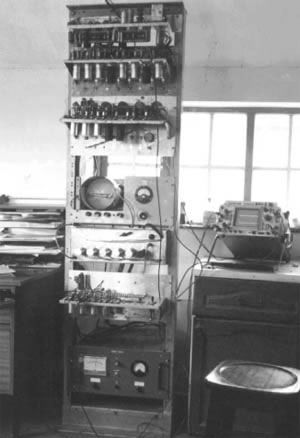Establishing credibility and funding
Although the steering group and I were highly confident that the project could succeed, it was clear to everyone that getting CRT storage to work again remained the highest risk. The purpose of the feasibility rig was to eliminate that risk as well as to convince supporters outside the project that we meant business. The rig (see Figure 2, next page) consists of a single rack with several selected chassis corresponding as closely as possible to those in the SSEM. The aim was to be able to store one or two lines of 32 bits, possibly with a half-adder so that we could observe a counting pattern. The minimum circuits required were a timing pulse generator, horizontal time-base generator, high-gain CRT signal amplifier, recirculation gate circuit, and the CRT itself. These were supported by appropriate high- and low-voltage power supplies and some control switches. Supplementary circuits included a flip-flop to make the CRT scan two lines alternately, and a half-adder chassis.

Figure 2. The feasibility rig in the author’s office prior to transporting to Manchester. (Photo by Christopher P. Burton.)
The feasibility rig was highly successful, and was demonstrated at the high profile launch of the various celebratory plans in Manchester Town Hall in March 1996. By that time, the authorities of the city of Manchester were also planning to contribute to the jubilee activities by coordinating “Digital Summer 1998” in the city, with various cultural and popular events. After this public appearance, the rig was enhanced in various ways to make it a useful test bed for training, and also as a signal source.
In mid-1995, a presentation was given to ICL’s Tom Hinchliffe, at the West Gorton plant, which was the descendant of the former Ferranti Computer Department that had engineered the University Mark 1 to make the Ferranti Mark 1 production computers. After listening to our plans, supported by fairly detailed costings and risk assessments, Hinchliffe generously offered sponsorship from ICL for the project. This was to consist of free provision of workshop resources and the purchase of any required materials, as well as incidental expenditures. This timely support allowed me to concentrate on planning and on technical matters, unencumbered by problems of seeking further funding.

